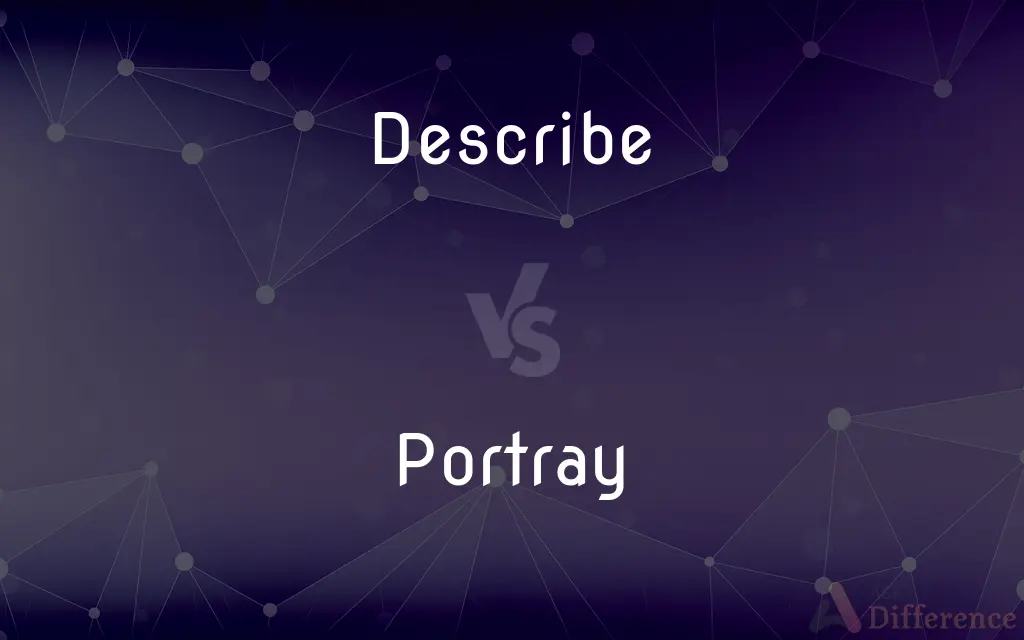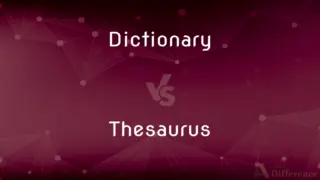Describe vs. Portray — What's the Difference?
By Maham Liaqat & Fiza Rafique — Updated on April 8, 2024
Describing involves detailing characteristics or features with words, while portraying involves representing or depicting something artistically or through images.

Difference Between Describe and Portray
Table of Contents
ADVERTISEMENT
Key Differences
Describing something is primarily about using words to convey the appearance, qualities, or essence of a subject. This process can be factual, focusing on objective traits, or it can involve subjective interpretations, where emotions and personal viewpoints come into play. On the other hand, portraying something goes beyond mere verbal explanation to include representation through various forms of art, such as painting, drawing, photography, or performance. Portrayal captures the essence, mood, and deeper qualities of the subject, often invoking a stronger emotional response from the audience.
When you describe, you are providing information that allows the listener or reader to visualize or understand a concept, place, person, or object using their imagination. This act relies heavily on the precision and vividness of the language used. Conversely, when you portray something, you create a visual or experiential representation of it, which can be directly perceived by others. This method often requires skill in a particular art form and can communicate complex ideas and emotions that words alone might not fully capture.
Description is crucial in contexts where understanding and clarity are paramount, such as in instruction manuals, academic texts, and factual reporting. Here, the goal is to inform, explain, and ensure comprehension. Portrayal, however, is more aligned with the arts and entertainment, where the objective is not just to inform but to evoke feelings, provoke thought, and engage the audience on a deeper, often more subjective level.
The tools and methods of description and portrayal differ significantly. Description uses linguistic devices, including adjectives, metaphors, and similes, to create a picture in the mind's eye. Portrayal, on the other hand, utilizes visual elements, such as line, color, form, and composition in visual arts, or character development and dialogue in literature and performance, to convey its message.
Despite these differences, describing and portraying can complement each other, especially in storytelling and artistic expression. A narrative might use description to set the scene or outline a character but then use portrayal through the character's actions, dialogue, and interactions to reveal deeper aspects of their personality and story. This interplay enhances the richness and depth of the experience, whether in literature, film, or visual arts.
ADVERTISEMENT
Comparison Chart
Medium
Primarily uses words.
Uses art forms (visual, performance).
Focus
Details characteristics or features.
Represents or depicts artistically.
Objective
To inform or explain.
To evoke feelings or provoke thought.
Methods
Adjectives, metaphors, similes.
Line, color, form, dialogue, action.
Contexts
Instructional, factual reporting.
Arts, entertainment.
Compare with Definitions
Describe
Objective and Subjective.
Descriptions can be objective, focusing on factual details, or subjective, incorporating personal impressions.
Portray
Art Forms.
Portrayal can involve various art forms, including painting, drawing, photography, and performance.
Describe
Informative.
The purpose of describing is often to inform or explain, making concepts clear and comprehensible.
Portray
Complex Ideas.
Through portrayal, artists communicate complex ideas, moods, and deeper qualities that words might not fully express.
Describe
Visualization.
Descriptions help listeners or readers visualize subjects in their mind's eye.
Portray
Emotional Response.
Portraying aims to evoke emotions and engage the audience's senses beyond mere factual representation.
Describe
Language Dependent.
Effective description relies on the careful choice of words and linguistic devices.
Portray
Engagement.
Portrayal seeks to engage the audience on a deeper level, provoking thought and feeling through artistic expression.
Describe
To give an account of in speech or writing
Describe a sea voyage.
Portray
To depict or represent pictorially; make a picture of
The painter portrays a typical country scene.
Describe
To convey an idea or impression of; characterize
She described her childhood as a time of wonder and discovery.
Portray
To describe or represent in words
The author portrays the world of the fantastically wealthy.
Describe
To represent pictorially; depict
Goya's etchings describe the horrors of war in grotesque detail.
Portray
To describe or depict in a certain way
The book portrays her as hardworking and driven.
Describe
To trace the form or outline of
Describe a circle with a compass.
Portray
To represent dramatically, as on the stage
The actor portrays an obsessed lover in the film.
Describe
(transitive) To represent in words.
The feeling is difficult to describe, but not unpleasant.
The geographer describes countries and cities.
Several witnesses describe seeing lights in the sky that night.
Portray
To paint or draw the likeness of.
I will portray a king on horseback.
Describe
(transitive) To represent by drawing; to draw a plan of; to delineate; to trace or mark out.
To describe a circle by the compasses;
A torch waved about the head in such a way as to describe a circle
Portray
(figuratively) To represent by an image or look.
Describe
To give rise to a geometrical structure.
The function describes a very complex surface.
Portray
(figuratively) To describe in words; to convey.
Describe
To introduce a new taxon to science by explaining its characteristics and particularly how it differs from other taxa.
The fungus was first described by a botanist.
Portray
To play a role; to depict a character, person, situation, or event.
For my next movie, I will be portraying Shakespeare.
Describe
(obsolete) To distribute into parts, groups, or classes; to mark off; to class.
Portray
(obsolete) To adorn.
Describe
To represent by drawing; to draw a plan of; to delineate; to trace or mark out; as, to describe a circle by the compasses; a torch waved about the head in such a way as to describe a circle.
Portray
To paint or draw the likeness of; as, to portray a king on horseback.
Take a tile, and lay it before thee, and portray upon it the city, even Jerusalem.
Describe
To represent by words written or spoken; to give an account of; to make known to others by words or signs; as, the geographer describes countries and cities.
Portray
Hence, figuratively, to describe in words.
Describe
To distribute into parts, groups, or classes; to mark off; to class.
Passed through the land, and described it by cities into seven parts in a book.
Portray
To adorn with pictures.
Spear and helmets thronged, and shieldsVarious with boastful arguments potrayed.
Describe
To use the faculty of describing; to give a description; as, Milton describes with uncommon force and beauty.
Portray
Portray in words;
The book portrays the actor as a selfish person
Describe
Give a description of;
He drew an elaborate plan of attack
Portray
Make a portrait of;
Goya wanted to portray his mistress, the Duchess of Alba
Describe
To give an account or representation of in words;
Discreet Italian police described it in a manner typically continental
Portray
Assume or act the character of;
She impersonates Madonna
The actor portrays an elderly, lonely man
Describe
Identify as in botany or biology, for example
Portray
Represent in a painting, drawing, sculpture, or verbally;
The father is portrayed as a good-looking man in this painting
Describe
Make a mark or lines on a surface;
Draw a line
Trace the outline of a figure in the sand
Common Curiosities
How do describing and portraying differ in their objectives?
Describing primarily aims to inform or explain, focusing on clarity and understanding, whereas portraying seeks to evoke emotions, provoke thought, and engage the audience on a deeper level.
What does it mean to portray something?
To portray something means to represent or depict it artistically or through images, capturing its essence in a form that can be directly perceived.
What does it mean to describe something?
To describe something means to use words to convey its appearance, qualities, or essence, providing a verbal representation that enables visualization.
Are there contexts where describing is preferred over portraying?
Describing is preferred in contexts requiring clarity and factual information, such as instructional content, academic texts, and factual reporting.
Can describing and portraying be used together?
Yes, describing and portraying often complement each other, especially in storytelling and artistic expression, enhancing the depth and richness of the narrative or artwork.
Why is language important in description?
Language is crucial in description because it is the medium through which characteristics, qualities, and essence are conveyed, requiring precision and vividness for effective visualization.
Is describing more factual than portraying?
Describing tends to be more factual, focusing on conveying objective information and details, while portraying often incorporates subjective interpretations and emotional depth.
Can portrayal convey ideas that description cannot?
Yes, portrayal can convey complex ideas, emotions, and moods that are difficult to fully express through words alone, engaging the audience's senses and emotions in a unique way.
Can portrayals be subjective?
Yes, portrayals are often subjective, reflecting the artist's vision, interpretation, and emotional intent, which can vary widely among different viewers or audiences.
In what contexts is portraying more effective than describing?
Portraying is more effective in the arts and entertainment, where the goal is to engage the audience emotionally and provoke thought through visual, auditory, or performance mediums.
What role does emotional response play in portrayal?
Emotional response is a key objective of portrayal, as it aims to engage the audience's emotions and senses, making the experience more immersive and impactful.
How does portrayal enhance artistic expression?
Portrayal enhances artistic expression by allowing artists to communicate deeper aspects of their subject matter, invoking emotional responses and thought-provoking insights through visual and performative art forms.
How do the methods of describing and portraying differ?
Describing uses linguistic devices like adjectives, metaphors, and similes, while portraying uses visual and performative elements like line, color, form, dialogue, and action.
How can description enhance storytelling?
Description enhances storytelling by setting the scene, outlining characters, and providing background information that allows the audience to visualize and understand the narrative context.
Share Your Discovery

Previous Comparison
Strabismus vs. Squint
Next Comparison
Dictionary vs. ThesaurusAuthor Spotlight
Written by
Maham LiaqatCo-written by
Fiza RafiqueFiza Rafique is a skilled content writer at AskDifference.com, where she meticulously refines and enhances written pieces. Drawing from her vast editorial expertise, Fiza ensures clarity, accuracy, and precision in every article. Passionate about language, she continually seeks to elevate the quality of content for readers worldwide.













































